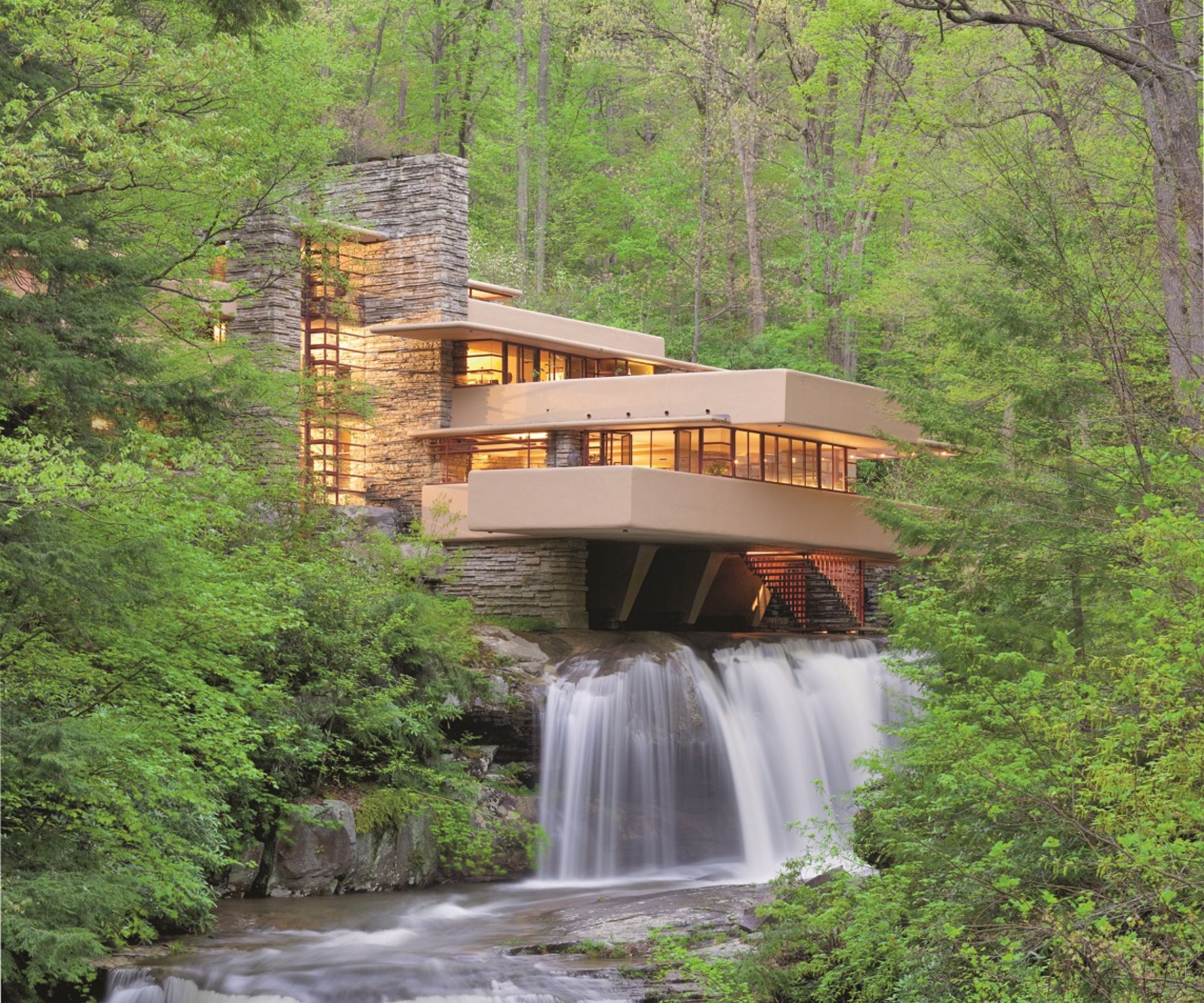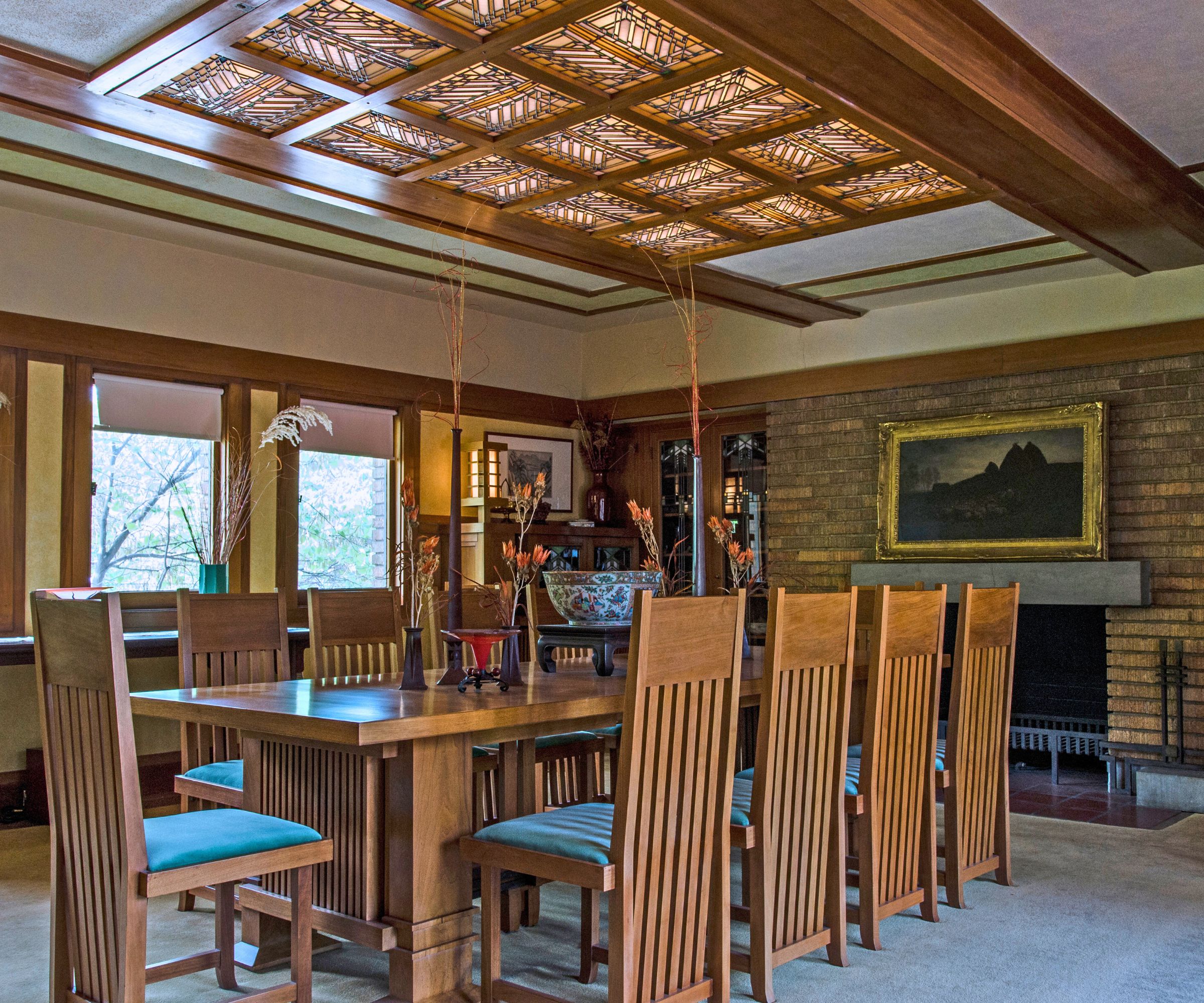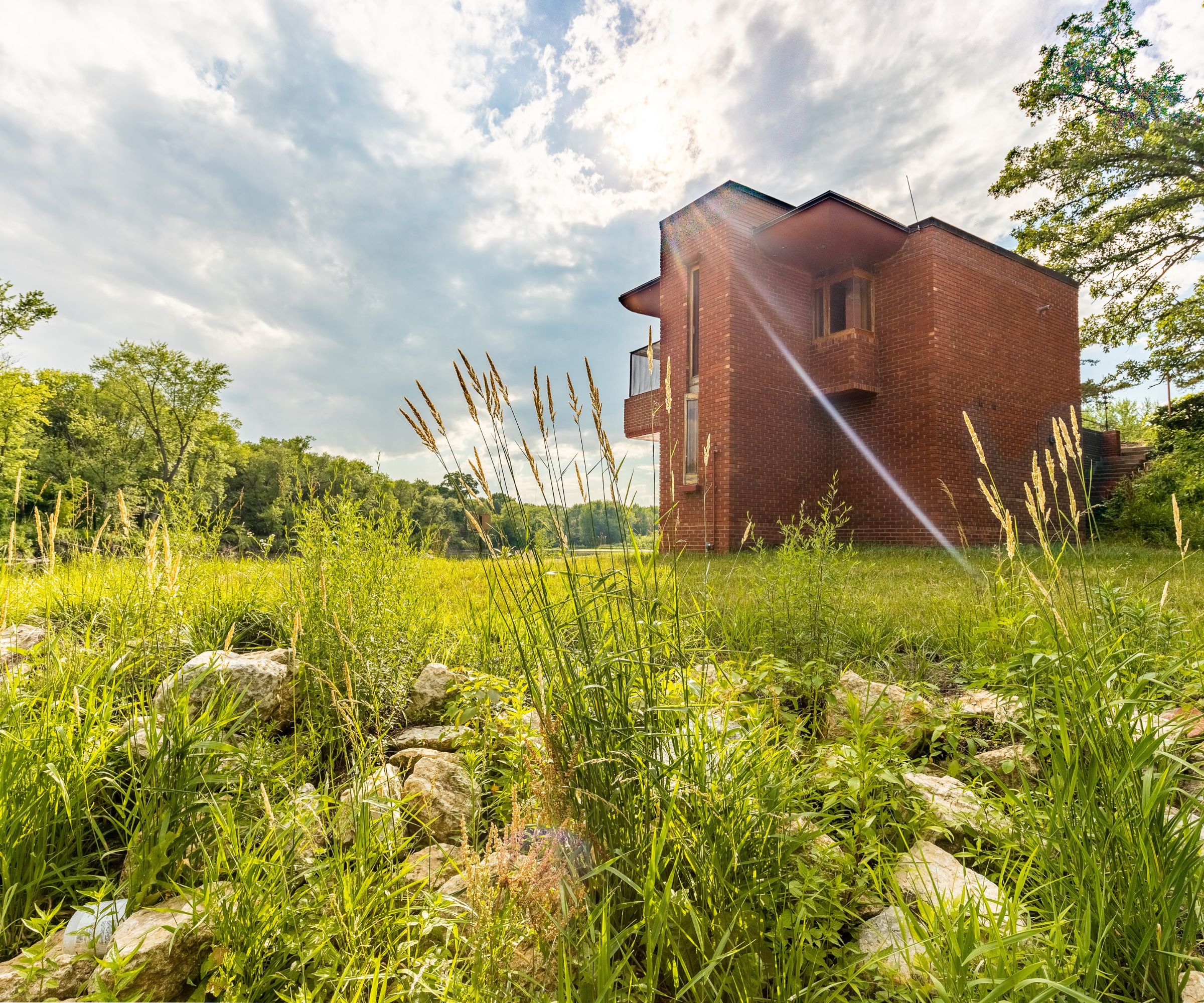10 Frank Lloyd Wright houses open to the public – tour the architect's iconic homes
Frank Lloyd Wright redefined domestic architecture with his groundbreaking designs. Here's our pick of homes you can visit


- 1. B Harley Bradley House, Illinois, 1900
- 2. Fallingwater, Pennsylvania, 1935
- 3. Allen House, Kansas, 1918
- 4. Taliesin West, Arizona, 1937
- 5. Cedar Rock, Iowa, 1945
- 6. Samara, Indiana, 1956
- 7. Hollyhock House, California, 1921
- 8. Laurent House, Illinois, 1949
- 9. Frederick C. Robie House, Illinois, 1910
- 10. Oak Park Home and Studio, Illinois, 1889
Architect Frank Lloyd Wright (1867-1959) is arguably the most influential figure in American architecture of all time. His groundbreaking approach to house design changed our landscape and redefined domestic architecture.
By far the best descriptors of Frank Lloyd Wright's style and philosophy are the three phrases he himself coined for his work:
Organic architecture – buildings that harmonize with their inhabitants and their environment, that are products of their place, purpose, and time. Frank Lloyd Wright's philosophy of organic architecture spanned his whole career, manifesting first in his prairie buildings, then later in his Usonian style
Prairie buildings – these low, linear, horizontal structures were designed to reflect the vast Midwestern landscape and appeared between 1900-1910. These homes were individually created for wealthy clients
Usonian style – around the mid-1930s, Wright first used the word 'Usonian' to describe his concepts for a new style of United States architecture for homes and cities, more attainable for a middle class clientele
Frank Lloyd Wright designed more than 1,000 buildings in the course of his long career, but it's his inspiring back catalog of house design we'd like to take a closer look at. And we'd like you to take a close look too.
The amazing Frank Lloyd Wright properties highlighted below are all open to the public, many featuring fittings and furniture designed by the architect. They were designed as private residences, but such was the great architect's influence on American living spaces that these homes now offer guided tours allowing us to share and better understand his designs and legacy.
We asked some of the house curators and custodians to tell us in their own words what makes their Frank Lloyd Wright properties special and why we should take the tours.
1. B Harley Bradley House, Illinois, 1900

'The B. Harley Bradley House (also known as Glenlloyd) is credited with changing the face of American architecture. Built in 1900 on the banks of the Kankakee River, Illinois, the house was the first example of Wright's Prairie style architecture. It was commissioned for B Harley Bradley and his wife Anna, and over the subsequent decade, Wright would incorporate elements of this first design into his other Prairie style homes. The house was fully restored in 2005 with almost all of Wright's original art glass windows intact. It was converted into a public museum in 2010,' says Bob Bohlmann AIA, Executive Director, B. Harley Bradley House.
Design expertise in your inbox – from inspiring decorating ideas and beautiful celebrity homes to practical gardening advice and shopping round-ups.
2. Fallingwater, Pennsylvania, 1935

This iconic property was designed in 1935 for the Kaufmann family, owners of Kaufmann’s Department Store. Wright designed Fallingwater to rise above the waterfall over which it is built, a perfect illustration of his organic architecture philosophy. The Pennsylvania property is the only major Wright-designed house to open to the public with its furnishings, artwork, and setting intact.

'Fallingwater's legacy is serving as an example of Wright's ideas. But, Frank Lloyd Wright aside, I think it's a place where people come to get inspiration, to be reminded of how important it is to spend time outdoors with nature,' explains Ashley Andrykovitch, Senior Director and Curator of Education at Fallingwater.
3. Allen House, Kansas, 1918

'The Allen House in Wichita, Kansas, is the hidden gem on the Prairie! When you tour the home, it feels like you are a guest of the Allens and they have just stepped away for a moment. The home has been restored back to the original footprint of 1918 and it truly exemplifies Wright’s philosophy of living in harmony with nature,' explains Amy Reep, Executive Director at the Allen House Foundation.

'With over 30 pieces of Wright-designed furniture, the original art glass intact and the restored gardens, the Allen House is a step back in time for our guests of how the Allens experienced the home. The house was the last of Wright’s famous Prairie style homes but was also very pivotal in the movement to the Usonian designs of 1935 as visitors will experience when they visit the home,' adds Amy.
4. Taliesin West, Arizona, 1937

'Taliesin West is a UNESCO World Heritage site and National Historic Landmark nestled in the desert foothills of the McDowell Mountains in Scottsdale, Arizona. Wright’s beloved winter home and desert laboratory was established in 1937 and diligently handcrafted over many years. Deeply connected to the desert from which it was forged, Taliesin West possesses an almost prehistoric grandeur. It was built and maintained almost entirely by Wright and his apprentices, making it among the most personal of the architect’s creations,' explains Rebecca Hagen, The Bruce Brooks Pfeiffer Director of Collections & Archives
5. Cedar Rock, Iowa, 1945

'In 1945, Lowell and Agnes Walter commissioned architect Frank Lloyd Wright to design them a retirement estate on a unique parcel of property they owned on the rocky banks of NE Iowa's Wapsipinicon River. Wright created a thorough design and an amazing space for entertaining in the garden room,' says Kathryn Hund, Cedar Rock State Park Manager.

'The space features a 1950 indoor garden and a 60' long climbing pothos all surrounded by three glass walls that dissolve the barriers between the indoors and outside. The property also includes the only boat house in Frank Lloyd Wright's portfolio with dedicated living space. Be sure to stop by and check out this site in person!' adds Kathryn.
6. Samara, Indiana, 1956

'Samara, the 1956 home of John and Catherine Christian in West Lafayette, Indiana, represents one of Wright’s most fully realized Usonian designs,' says Nathan Allaire, curator of Samara. The 2,200 square-foot Samara was designed towards the end of the architect's career and was designated as a National Historic Landmark in 2015.

'Everything, from the landscaping and furniture to accessories and linens, bears the architect’s imprint. Today, the home affords visitors from across the world the rare and immersive opportunity to experience Wright’s comprehensive vision,' adds Nathan.
7. Hollyhock House, California, 1921

Hollyhock House was Frank Lloyd Wright’s first Los Angeles commission. It was built between 1919 and 1921 as the personal residence for oil heiress Aline Barnsdall, who asked Wright to incorporate her favorite flower, the hollyhock, into the home’s design. The house was to be the centerpiece of her plans for a cultural arts complex with a major theater, cinema, artist residences, and commercial shops.
Writing about the commission in his autobiography, Wright says: 'Now, with a radical client like Miss Barnsdall, a site like Olive Hill, a climate like California, an architect head on for freedom, something had to happen… So this Romanza of California came out on Olive Hill.'
Hollyhock House is now owned by the City of Los Angeles and operated by the Department of Cultural Affairs.

In 2019 Hollyhock House became LA's first World Heritage Site. Eric Garcetti, who was the mayor of Los Angeles at the time, said: 'Hollyhock House is one of Los Angeles’ greatest cultural treasures – a landmark elegantly rendered from Frank Lloyd Wright’s imagination and Aline Barnsdall’s vision. The history of this home and its excellent craftsmanship will inspire Angelenos for generations to come, and Hollyhock House’s well-deserved place on UNESCO’s World Heritage List is a fitting tribute to this bold structure.'
8. Laurent House, Illinois, 1949

'Every morning for 60 years, I would come out of my bedroom and pause in the doorway, sitting in my wheelchair, to look down the window wall, I’d take in the beauty that Wright designed, seeing both the indoors and outdoors, as if there were no barriers. That scene allowed me to forget about my disabilities and focus on my capabilities,' said Ken Laurent of the house Frank Lloyd Wright designed for him in 1949.
'The Laurent House, in Rockford, Illinois, is unique as the only home Wright designed to be wheelchair accessible. Ken Laurent, a WW II veteran who suffered a spinal cord injury, reached out to Wright in 1948 to request a home that would accommodate his unique needs. The house was completed in the summer 1952 and enjoyed by Ken and Phyllis Laurent for more than 60 years. The house opened as a public museum in 2014 and welcomes guests from around the world each year,' says Mary Beth Peterson, Executive Director of Laurent House Foundation.

'The Laurent House museum is complete with furniture and textiles, also designed by Wright. Visitors will discover how far ahead of his time its creator was in designing an accessible home that truly gave Ken Laurent a rich and fulfilling life,' adds Mary.
9. Frederick C. Robie House, Illinois, 1910

The Frederick C Robie house in Chicago, Illinois, was designed by Wright between 1908-1910 as a single family home. The architect described it as 'a cornerstone of modern architecture.' The Prairie style house, inspired by the wide plains of the American Midwest, is still considered one of the most important buildings in architectural history.

'One of the great masterpieces of 20th-century architecture and design, the Frederick C. Robie House synthesizes all the major innovations of Wright’s design philosophy. It is the definitive expression of his Prairie style and was inscribed on the UNESCO World Heritage List in 2019,' explains Christine Trevino, Communications Manager for the Frank Lloyd Wright Trust.
10. Oak Park Home and Studio, Illinois, 1889

The architect's Chicago home was where it all began and so is a fitting place to contemplate just how much Frank Lloyd Wright achieved during the course of his long career.
'Frank Lloyd Wright’s first home and studio in Oak Park (1889-1909) was the birthplace of an architectural revolution. Wright used his home to explore design concepts that went on to shape his architectural philosophy. In his studio, Wright and his associates developed a new American architecture – the Prairie style. The surrounding historic district has the greatest number of Wright-designed houses worldwide,' explains Christine Trevino, Communications Manager for the Frank Lloyd Wright Trust.
The properties featured above are just a taster of the many Frank Lloyd Wright homes open to the public.
We've picked out some of the most famous of the architect's houses, and some of our personal favorites. We hope they will inspire you to visit in person, and perhaps to go on and discover your own favorite Frank Lloyd Wright houses.
Karen sources beautiful homes to feature on the Homes & Gardens website. She loves visiting historic houses in particular and working with photographers to capture all shapes and sizes of properties. Karen began her career as a sub-editor at Hi-Fi News and Record Review magazine. Her move to women’s magazines came soon after, in the shape of Living magazine, which covered cookery, fashion, beauty, homes and gardening. From Living Karen moved to Ideal Home magazine, where as deputy chief sub, then chief sub, she started to really take an interest in properties, architecture, interior design and gardening.
